Floyd Bloom: Neuroscience was not even a word
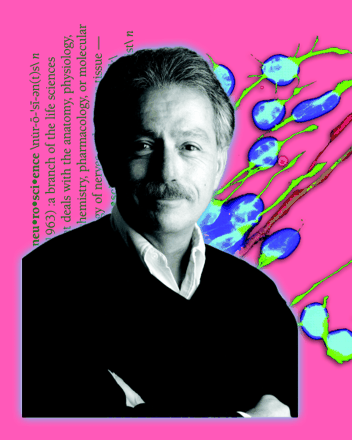

Floyd Bloom says that he grew up, surrounded by doctors and pills, in a drug store in Dallas, where his father and uncles were pharmacists. He is a natural storyteller, readily recalling the people and events that have shaped his career. His narrative skills were apparent as early as high school, where he was encouraged, partially on the basis of aptitude tests, to pursue a career in journalism or public relations, and to stay away from hard subjects like math and science. In college, he majored in German literature, although he pursued premedical studies in accordance with his father's wishes. During his medical school and residency experiences in St. Louis, he recounts, he always attempted to carry in his mind an organized way of explaining his academic and clinical activities to the professors and attending physicians that might quiz him. His subsequent research into the central nervous system similarly benefited from his ability not only to anticipate and formulate questions, the answers to which often required the development of new methods, technologies, and alliances, but also to place his findings in novel contexts where they could be conceptually appreciated and utilized. The prospect of telling good scientific stories was one of the factors that later drew Bloom to the position of Editor-in-Chief of Science magazine (1995-2000). While there, he was instrumental in widening the contexts in which the magazine presents science, and in shaping the ways that scientific information is electronically disseminated across the globe. Currently on sabbatical from Scripps, Floyd Bloom continues to explore, as CEO of a startup company in La Jolla, the entrepreneurial contexts in which his own research can be applied.
MI: Were you thinking at all about a research career when you entered medical school?
FB: No, initially I was going to be an obstetrician. I found that I enjoyed clinical medicine as a diagnostics game—you're always looking for angles, you're always asking questions, you're always doing probing tests.
MI: So how did the transition away from the clinic occur in your career?
FB: Well, the aptitude tests that had said I should stay away from mathematics were in some respect right, because the one course at Washington University School of Medicine where I didn't excel was Physiology, and the part of physiology I could not get was the Hodgkin-Huxley equation. My professor, Gordon Schoepfle, spoke in calculus, something I had never studied. But he thought that I should go into his lab during the summer after my first year of medical school, and so I learned that it really wasn't so complicated when you worked through it experimentally. And eventually I did my Honor's thesis between the Pharmacology and Physiology Departments. Then, as a senior medical student, I was appointed as an Assistant Instructor in the Department of Pharmacology, which meant that I got to eat lunch every day with the faculty, particularly the great pharmacologist Oliver Lowry. He was probably one of the great influences in my life to become a pharmacologist.
And then when I finished medical school I had my eye set on becoming Chief Resident, part of which was to earn a Research Associate post at the National Institutes of Health. So I went to the NIH to interview with Dr. Robert Berliner, who listened about my thesis on the kinetics of procaine binding to peripheral nerves, and then he said, “There's this funny program over at St. Elizabeths Hospital—they do something with the nervous system. Why don't you take a taxi cab over there and interview with them and see if you can get on with them.” And so I went over and met the man who would indeed become my boss, Gian Salmoiraghi. I went there two years later, after my first year of residency in St. Louis, and in the interim he had developed the five-barrel micropipet microiontophoresis technology. The lab had gone much more heavily into pharmacology, and Rudolf von Baumgarten, who was an expert in the olfactory bulb, was there at that time. So our first experiments were on the olfactory bulb, which was a really neat thing because you could stimulate the various pathways in and out, and really do synaptic-level pharmacology. And that really became my whole center of attention, and all of my papers from that point on were CNS papers. Erminio Costa, who was in Dr. Brodie's lab at that time, would come over and work with us two or three days a week, and I learned a lot of pharmacology from him.
Based on those experiences, I told my professor of medicine in St. Louis that I really didn't think that I was going to come back for my second year of residency and that I was instead going to pursue brain research. His response was, “Can you make a living doing that?” He was concerned as to where my career would go from that point; neuroscience was not then a word.
MI: So you obviously had questions that you wanted to pursue. What were they?
FB: Well, we didn't know where the fibers were that contained the transmitters that we were trying to test by iontophoresis. Elkes and Kety had come up with the concept in the 1960s called “regional neurochemistry,” which meant that the brain was not merely a fat body loaded with chemicals floating around, but that there were parts of the brain that were specifically enriched. But we didn't know what the details of those regionalities were. Most studies had been based on cutting tracts and watching nerve tracts degenerate, and those studies were limited to myelinated fibers to see their degenerative by-products. Cholinesterase staining was otherwise the state of the art at that point.
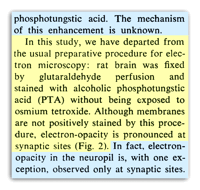
Science 154, 1575 (1966).
After the second year as Research Associate at St. Elizabeths Hospital, I went to Yale University on a Special NIH Fellowship and worked with Russell Barrnett, who had just developed cholinesterase staining for the electron microscope. I was able to use Dr. Barrnett's technician a great deal, with whom I was trying to get heavy-metal stains to react with the synaptic vesicle families. On one occasion, when we were trying phosphotungstic acid to place tungsten into the tissue, the technician didn't read my handwriting correctly and left out the final osmium fixative. When we cut the tissue and put it in the electron microscope, I didn't know at first what we were looking at, but I knew it was really important. We had images of just synapses…just the synaptic connections. So you could see the synapses at low power in the electron microscope, which meant that you could then quantify synaptic density. George Aghajanian, who is still at Yale, and I did several papers looking at the effects of development on the growth of synapses in specific regions. We localized for the first time the reuptake of radioactive norepinephrine and serotonin by electron microscopic autoradiography.
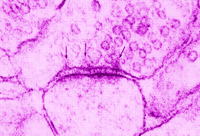
Brain Res. 6, 721 (1967).
At about that time, Dr. Salmoiraghi, who had previously been my boss at the NIH, was further up the ladder. The group at St. Elizabeths Hospital was now a Division of the National Institute of Mental Health, and he invited me and Costa, who had gone to Columbia, to come back and be part of this Division. Yale was a great place to be, but I was frustrated by being a faculty member, required to give so many lectures and sit in on so many committees. So when the offer came that I wouldn't have to write grants and could devote my entire time to doing research, I was ready to go back to the NIMH at St. Elizabeths Hospital as Chief of the Section of Cytochemical Pharmacology.
MI: Was the application of your research to mental health part of your motivation in moving to the NIMH?
FB: Well, there were wards at St. Elizabeths Hospital in the building where our division was, and if you ever needed motivation to work on brain problems, it was in your face all the time. I was always fascinated by depression, because the medication that I had been working on when I first came to St. Elizabeths was reserpine, used to treat high blood pressure, my original interest. But the drug caused a terrible side effect: about 20 percent of treated patients would become so depressed that they would try to commit suicide. When I returned to St. Elizabeths Hospital, Brodie and his people were working on the actions of reserpine on the central nervous system, and when Costa would come over, we would talk about this interesting problem.
MI: So people were really beginning to look at these behavioral disorders in terms of biochemistry?
FB: The fact that reserpine caused depression in people and depressed locomotor behavior in animals was really one of the first indications that chemical systems were linked to emotionality and behavior—a link that we all take for granted today. It was just a neat time. I remained at the NIMH from 1968 to 1975. Every day was a day of discovery. Desmethylimipramine was just becoming recognized, and Julius Axelrod's lab was working on its influence over the reuptake process, which itself hadn't been known for very long. The fact that you could sequester radioactive neurotransmitters into nerves was just mind-boggling.
MI: You said that you were in part drawn back to the NIMH because you would be able to devote yourself entirely to your research. Did things turn out that way?
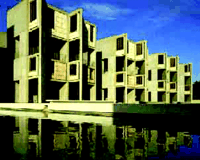
FB: Well, within about a year, Salmoiraghi became Director of the Laboratory for Neuropharmacology and I was picked to be the lab Chief, and from that point on I started doing administrative things as well as my lab things. I wasn't ready for it, but it's a familiar story: If I didn't take on the administrative tasks then somebody else would have to and I didn't want to risk being under somebody else's control. A few years later, Salmoiraghi left the NIMH for greener pastures and I was then tapped to be Acting Director of the Division of Special Mental Health Research. They wanted me to become the regular Director, but I received the opportunity to move to the Salk Institute and got 8000 square feet of lab space. My labs were right next to Roger Guillamin at the time that he won his Nobel Prize—it was a great, exciting time. And although 8000 square feet sounded like a lot of space when I moved there, as the programs grew and expanded, I had all these excellent people and I would have to let them go because there was no way for them to grow to be independent within my space. I hated to leave La Jolla because it's such a wonderful place, and I had become friendly with Richard Lerner at Scripps and he said, “Well, if you're going to leave town anyway—we wouldn't recruit you from the Salk Institute—but if you're going to leave town anyway, we'd like to keep you in San Diego and here's the opportunity.”
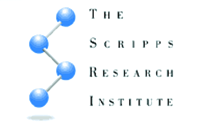
MI: Was lab space your only motivation for moving to The Scripps Research Institute?
FB: We already had been working together in my labs at Salk and Richard's labs at Scripps on the molecular biology of the brain, looking for mRNAs in the brain that are unique to what the brain does—we wanted to discover interesting opportunities for pharmacological development by understanding new genes. And so Greg Sutcliffe, who's a professor at Scripps, and Rob Milner, a former postdoc of mine, started doing early cloning. And people would say, “What are you looking for?” And we'd just say, “We don't know! We're just looking for genes that the brain uses that other tissues don't use.” Being next to Dr. Guillamin and understanding how many novel transmitters are expressed in specific nuclei of the hypothalamus was one of the motivations for a series of experiments that Greg did that led to the discovery of hypocretin, the neuropeptide that is mutated in human narcolepsy. And it was discovered strictly on the basis of the question, “What genes does the hypothalamus use that the cortex doesn't use?” People thought that we wouldn't be able to discover anything that way, but in fact today that is a standard mode of research and that question is the basis for all the science going on in the building that we're sitting in.
MI: You're talking about Neurome, the business for which you are now CEO?
FB: Well, Neurome is a chemical neuroanatomy company. But this building belongs to DGT [Digital Gene Technologies], who put their own money into us [Neurome] and have given us space in this building and the use of a lot of their infrastructure. DGT came from a series of grants that Greg and I had done, and we just kept on refining his technique and explained it to his brother, Bob Sutcliffe, an entrepreneurial lawyer, who found it not only a great business idea, he also became president of the company. So with Greg the discoverer, my job was to map the genes out and to try to deduce gene function on the basis of the sets of neurons where expression occurs. When I had previously worked with Greg, every time he would come up with a new gene and I would map it out, it would require me to go back to the textbooks and figure out what that place in the brain is and what is known about that place. About three years into my time [as Editor-in-Chief] at Science—during which I was regularly coming back west to meetings of the DGT Science Advisory Board—I saw that DGT was quickly moving along in terms of detecting genes that were affected by this or that perturbation. It struck me that we were ready to analyze our gene expression sets in terms of a functional assessment, and so Neurome was formed with the idea that we would devise ways to make new brain atlases and detect differences among transgenic mice. With DGT's help, we were able to get a joint venture contract from Elan Pharmaceuticals, and so within a week after the company was officially launched, we had a joint venture going that gives us revenue for the next three years.
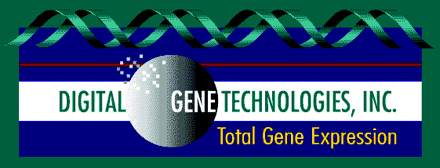
MI: Were you consciously orchestrating, with your move into business at the same time you were at Science, a career change?
FB: I just think I was ready for something different. I had been Department Chairman for nearly ten years, and it was a way to have an identity and nurture good people, but it was maybe not quite enough. And the Editor-in-Chief of Science has a tremendous bully pulpit from which to make editorial judgments. The opportunities of science were looming large and it just seemed to me that I could occasionally make some statements, and certainly invite people to make statements publicly, that would get points of view across that would otherwise be missed by the scientific leadership. And I was Editor-in-Chief as sort of a commuting job between the east and the west coast. I would go to Washington whenever it was necessary, and I did a lot of traveling on behalf of Science, as well. The Japanese government at that point was putting a lot more money into their scientific investment, relatively, than was the United States, and we looked at the Japanese science opportunity as a way of building our subscriptions to Science. So Japan and Europe were our two great opportunities to internationalize the magazine. We also established a relationship with the Chinese government to have Science electronically distributed all over the nation through the national academy of natural sciences in China. And we did a lot of other interesting things that I look back on with great pleasure. We started Science's NEXT WAVE, an electronic magazine for graduate students and others with career concerns. We started the online version of Science, which was right up there with the very first of the online magazines. And then we electronified, with the help of the Mellon Foundation, all of Science back to volume 1, issue 1.
MI: Was it clear to you when you started out at as Editor-in-Chief of Science how important the move to electronic publishing was going to be?
FB: When I got to Science, it was quickly explained to me that the price for paper was going up. The price for postage was going up, and I was asked where in the budget did I want to make the cuts in order that we wouldn't be in a deficit. And so it occurred to me, if I was constantly going to be confronted by changes in paper costs and postal rates, which I couldn't control, I would have to find another way to distribute the magazine. And we decided we had to be online quickly.
MI: So the age of electronic publishing really came to fruition while you were at Science. Were there issues that you faced for which you really had to define limits as to how far electronic publishing could go?
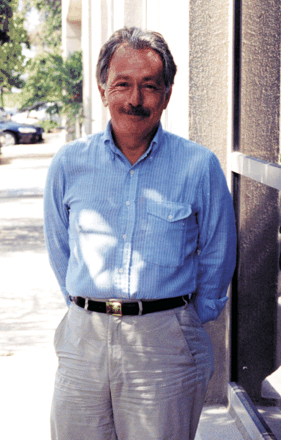
CEO Bloom outside the labs of Neurome, Inc.
FB: Well, PubMed Central [the initiative put forth by the National Library of Medicine to archive and disseminate biomedical research findings] was one of the last issues that I faced, and I think, faced down. It was wrong-headed in its origins. But the concept that people should have access to the scientific literature is of course a good one. Scientists want to have access to research findings so that they can pursue experiments. And when scientists are confronted by a publisher's wall that says you must be a subscriber to get in here, you'd like to find a way to get around it.
But to me, nothing is free. I am aware of the cost of making a prestigious publication. The cost of rejecting 95 percent of all the papers that are submitted makes the accepted ones so valuable. And there's only twenty-four hours in a day, no matter how intense your efforts to keep up with research reports. If I have time to read, I'm going to read in a place where I know that the information has been thoroughly vetted, and so I limit my reading to places where I can trust the judgment of the editors. If everything were free, and everybody could publish everything they want to, anyplace, I'd have no way to know how to sort things out. I certainly don't have time to read through a lot of very provocative assertions that turn out not to be true.
MI: In addition to culling out weaker manuscripts so as to add value to publications such as Science, how else do publishers add value to what they offer their subscribers?
FB: Well, the review process and the copyediting components impose clarity and make materials more accessible to readers who don't understand the jargon of a particular discipline. But Science was also able to complement the actual scientific paper by having news reporters who understand the science and explain it in even simpler terms. We created several features that help you focus quickly on what you might find most interesting for your own career. We expanded news coverage and special perspectives from experts who tell you why a given paper is important, because the findings may be too arcane for the ordinary person to understand. The whole middle of the magazine was expanded in order to help people understand where science is going, where it's been, what the issues are, because very few people can read all the papers in Science magazine.
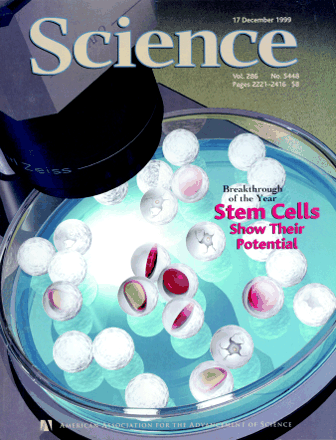
MI: In attempting to give context to particular areas of research for the non-expert, did you encounter any opposition? Did any scientist say, “We don't want some editor to impose his or her views onto what's being reported scientifically!”?
FB: No. The best thing is to have controversy in an intellectual manner because people read it. They like to see the Christians fight the lions, right? And so if you can engage in an intellectual discussion, then you attract readers and at the same time people get informed from the debate because they'll learn parts of alternative arguments.
MI: Well, speaking of alternative arguments and technological developments, the issue of stem cells has recently become important to many sectors of society. Where do you think research in that area might go?
FB: The concept of stem cells as an aspect of biomedical research first became apparent to me about four years ago. I was floored by the potential. The idea of adult stem cells was our 1999 Breakthrough of the Year in Science, because of the enormous potential. Where I might not be as enthusiastic as some is the reality of brain stem cells in human beings. I think they are very, very rare. We're just on the very threshold of entering the very long and tortuous road to being able to develop stem cell technology and to overcoming some of the immunological and neurobiological barriers to replacing missing or dead neurons in the brain. It may surprisingly—pleasantly—go very fast, but as I see it, it's going to be very difficult. But the opportunity to derive cells from umbilical cords and placentas, which can be coaxed into being this or that, is a tremendous opportunity for medicine. For liver and for kidney, I think it has tremendous opportunity. Some day it may have opportunities for nervous system research, but there are just much more difficult questions that have to be answered first. The work that John McDonald and Dennis Choi have done at Washington University on repairing the spinal cords of traumatized rats is very impressive. Exactly how and what it is that those stem cells are doing in that cavity ten days after—that's going to be a very interesting set of biological developments.
MI: What role will pharmacology as a discipline play in terms of how therapeutic stem cells and other novel biomedical technologies come to fruition?
FB: Such as gene therapy and antisense oligonucleotides? I think those are all important developments, and for too long we have been in the box that pharmacology is only the study of small chemicals. But I think we will expose those opportunities very usefully. That's what we had in mind at Scripps, in 1989, when we merged neurovirology and neuroimmunology with more classical, transmitter-based neuropharmacology into our Department of Neuropharmacology. In addition to efforts in alcohol and substance abuse research, the Department was formed with the idea that future ways of medicating the brain would not be limited to small chemical molecules as we understand them, but would include viruses that would infect and give off special kinds of gene products that would restore function and help the brain repair itself—or prevent the immune system from attacking the brain as it does in multiple sclerosis. Virus-mediated gene transfer has been hyped for a long time, and so far it has yet to become really effective for almost anything. But people are working hard on that, and we have a lot more knowledge on which to base that kind of thrust than we ever had before. And pharmacology is the key linkage, right? Because as a pharmacologist you are a physiologist but you're also a biochemist and you can also be a behaviorist.
- © American Society for Pharmacology and Experimental Theraputics 2001



